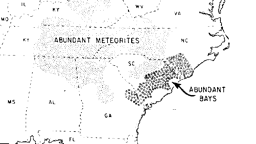 |
Science Frontiers ONLINE No. 82: Jul-Aug 1992 |
|
|
DID A HALF MILLION METEORS FALL ON THE CAROLINAS?
The Carolina Bays get scant notice in the literature these days, but E.R. Randall has rescued them this undeserved obscurity.
"For years, people living along the Carolina coast have marveled at a series of strange, oval-shaped depressions in the ground called 'Carolina Bays.'"From the air these shallow, marshy bogs created a landscape that resembles the pockmarked surface of the moon. They crisscross each other in a chaotic tapestry, but at ground level are hardly noticeable because of thick forests and semitropical swamplands.
"Highways and modern housing developments have all but obliterated thousands of the bays, leaving them visible only to trained eyes.
"Still, it is estimated that no fewer than 300,000 such bays, ranging from a few feet across to almost two miles in diameter, dot the East Coast landscape from southern New Jersey to northeastern Florida. One source places the number at more than half a million."
 Map showing areas of abundant Carolina Bays and frequent meterorite finds. However, meteorites are rare in the areas of the bays. |
"'These half-million shallow craters represent the visible scars of but a small fraction of the meteors that fell to earth...when a comet smashed into the atmosphere and exploded over the American Southeast,' Savage wrote. 'Countless thousands of its meteorites must have plunged into the sea beyond, leaving no trace; while other thousands fell into the floodplains of rivers and streams that soon erased their scars.'"
(Floyd, E. Randall; "Comet May Have Created Carolina Bays," Birmingham News, May 16, 1992. Cr. E. Kimbrough.)
Comment. Floyd neglected to mention that D. Johnson, a critic of the comet theory, wrote a whole book (The Origin of the Carolina Bays) based on his own theory of spring-sapping.
For more information on the Carolina Bays, consult our catalog: Carolina Bays, Mima Mounds. Details here.